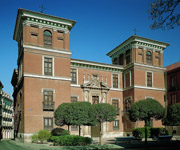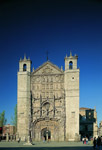PALACES AND HERITAGE
Majestic buildings
Across the streets in Valladolid there are buildings with a great cultural value. These palaces and big houses describe the history of the city.
PIMENTEL PALACE
King Philip II was born in the Pimentel Palace in 1527. The vestibule is decorated with tiles recreating different events in the city’s history. The palace is currently home to the Provincial Council.


FABIO NELLI PALACE
A Renaissance palace erected in the 16th century. It currently houses the Valladolid Museum of Archaeology.


BENAVENTE PALACE
The Plaza de la Trinidad square is flanked by what was formerly the Palace of the Counts of Benavente (16th century) and where the city Hospice was housed in the 19th century, an institution run by the Brotherhood of St Joseph for Abandoned Children in the 16th century, it was also the place where Cipriano Salcedo studied..

ROYAL PALACE
The Royal Palace was seat of the Court under Philip III and Margaret of Austria and the birthplace of Philip IV (1605). Of particular note are the Renaissance courtyard and a 18th century Imperial staircase.

CATHEDRAL
Construction work commenced in 1527, building over an already existing collegiate church. The cathedral was designed with the intention of becoming the most important church in Spain, however subsequent problems put an end to this dream. A number of important artists have left their mark on this building, such as the architect Juan de Herrera, responsible for the project; the master Churriguera, who completed the façade and Juan de Juni, the author of the altarpiece. Inside the cathedral is the Diocesan Museum, holding works by Juan de Arfe and Gregorio Fernández.


CHURCH OF SAN PABLO
The Church of San Pablo (St Paul’s) is one of the most outstanding examples of Gothic architecture in the city. The Church of San Pablo (St Paul’s) is one of the most outstanding examples of Gothic architecture in the city. Although its origins are linked to the closing years of the 13th century, the temple was considerably renovated during the final third of the 15th century, during the reign of the Catholic Kings. In fact, we can find badges of them in the Church.
The Church has a spectacular façade. It was designed as a great retable in Spanish – Flemish Gothic style.



CHURCH OF LA ANTIGUA
The church of Santa María la Antigua is known as the “queen of the Romanesque towers of Castile”. The building is crowned by a pyramid steeple with a slab tiled roof.

CHURCH OF LAS ANGUSTIAS
The Calderón Theatre is located in the street of Las Angustias, opposite the Church of Las Angustias (late 16th century), a penitential church model. It contains the carvings of the “Cristo de los Carboneros” (Christ of the Carbon makers) and the “Virgen de las Angustias” (Virgin of Anguish), one of the masterpieces by Juan de Juni, also known as the “Virgen de los Cuchillos” (Virgin of the Knives).
















